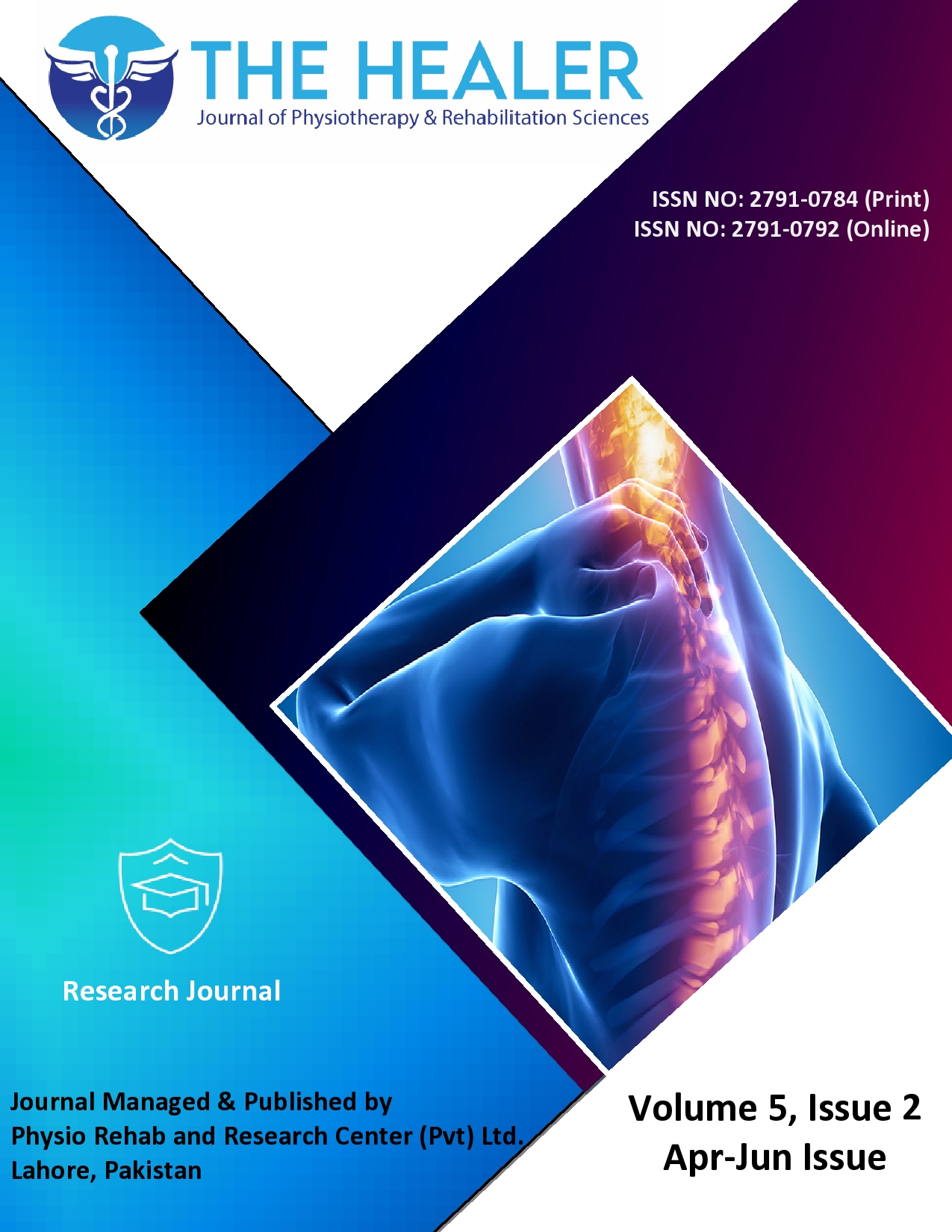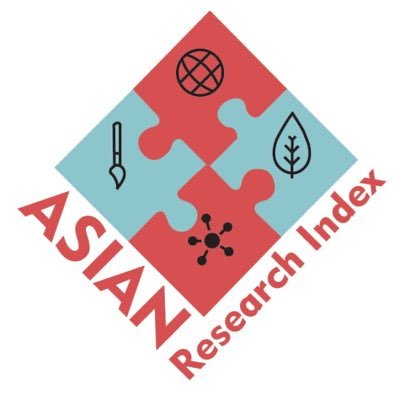Effects of Transcutaneous Auricular Nerve Stimulation versus Body Rocking Exercises on Upper Limb Spasticity in Young Stroke Patients: A Randomized Clinical Trial
DOI:
https://doi.org/10.55735/jv4f0q56Keywords:
Body rocking exercises , Motor function , Spasticity , Transcutaneous auricular nerve stimulation , Young stroke patientsAbstract
Background: Upper limb spasticity is one of the most crippling effects of stroke, which continues to be a major source of long-term impairment globally. It has a major effect on quality of life, everyday functioning, and motor control, especially in young stroke survivors. Objective: To compare the effects of transcutaneous auricular nerve stimulation versus body rocking exercises on upper limb spasticity in young stroke patients. Methodology: A randomized clinical study with blinded outcome evaluation was conducted at the Superior University and City Clinic Physiotherapy and Rehabilitation Center in Lahore. Participants were randomly assigned to either Group A, treated with transcutaneous auricular nerve stimulation, or Group B was given body rocking exercises. If they had upper limb spasticity following a stroke and were between the ages of 35 and 45. The interventions lasted for eight weeks. The results were measured using the Modified Ashworth Scale, Numeric Pain Rating Scale, Stroke Impact Scale, and Fugl-Meyer Assessment for Upper Extremity. The statistical analysis was conducted using non-parametric tests. Results: Both groups showed statistically significant improvement from baseline in all outcome measures (p<0.05). However, Group B exhibited significantly greater post-treatment improvements in spasticity (p=0.00), pain (p=0.00), motor function (p=0.02), and quality of life (SIS, p = 0.00). Within-group analysis confirmed consistent improvement in both groups, but the magnitude was higher in the body rocking group. Conclusion: Young stroke patients’ upper limb stiffness can be effectively managed with Transcutaneous auricular nerve stimulation and body rocking exercises. Nonetheless, body rocking exercises showed better results in every category, indicating that they have a higher potential to support neuroplasticity recovery and functional independence. These results provide credence to the use of rhythmic, body-based therapies in post-stroke rehabilitation programs, particularly in environments with limited resources.
Downloads
References
1. Feigin VL, Brainin M, Norrving B, et al. World stroke organization: global stroke fact sheet 2025. International Journal of Stroke 2025; 20(2): 132–44. DOI: https://doi.org/10.1177/17474930241308142
https://doi.org/10.1177/17474930241308142 DOI: https://doi.org/10.1177/17474930241308142
2. Jung K-s, Jung J-h, Cho H-y, In T-s. Effects of transcutaneous electrical nerve stimulation with taping on wrist spasticity, strength, and upper extremity function in patients with stroke: a randomized control trial. Journal of Clinical Medicine 2024; 13(8): 2229. DOI: https://doi.org/10.3390/jcm13082229
https://doi.org/10.3390/jcm13082229 DOI: https://doi.org/10.3390/jcm13082229
3. Suputtitada A, Chatromyen S, Chen CP, Simpson DM. Best practice guidelines for the management of patients with post-stroke spasticity: a modified scoping review. Toxins 2024; 16(2): 98. DOI: https://doi.org/10.3390/toxins16020098
https://doi.org/10.3390/toxins16020098 DOI: https://doi.org/10.3390/toxins16020098
4. Mei J, Xue Y, Li J, et al. Effects of functional acupuncture on upper limb spasticity after ischemic stroke: a protocol for a randomized controlled parallel clinical trial. Frontiers in Neurology 2022; 13: 835408. DOI: https://doi.org/10.3389/fneur.2022.835408
https://doi.org/10.3389/fneur.2022.835408 DOI: https://doi.org/10.3389/fneur.2022.835408
5. Rahman-Enyart M. The Efficacy of Perturbation-Based Balance Training on Preventing Falls in Older Adults: A Systematic Review and Synthesis without Meta-Analysis (SWiM): Indiana University; 2022.
6. Reebye R, Jacinto LJ, Balbert A, et al. Multimodal therapy and use of adjunctive therapies to BoNT-A in spasticity management: defining terminology to help enhance spasticity treatment. Frontiers in Neurology 2024; 15: 1432330. DOI: https://doi.org/10.3389/fneur.2024.1432330
https://doi.org/10.3389/fneur.2024.1432330 DOI: https://doi.org/10.3389/fneur.2024.1432330
7. Zhao S, Zhang MM. I-Health-Designing a Smart Massage Product-Service System for the Sub-health Status of Young People Based on Traditional Chinese Tuina Therapy. International Conference on Human-Computer Interaction 2023; 459–69. DOI: https://doi.org/10.1007/978-3-031-49212-9_57
https://doi.org/10.1007/978-3-031-49212-9_57 DOI: https://doi.org/10.1007/978-3-031-49212-9_57
8. Joshua AM, Karthikbabu S, Joshua AM, et al. Therapeutic approaches. Physiotherapy for adult neurological conditions: Springer; 2022: 31–183. DOI: https://doi.org/10.1007/978-981-19-0209-3_2
9. Spina S, Facciorusso S, Cinone N, et al. Integrating telemedicine in botulinum toxin type-A treatment for spasticity management: perspectives and challenges from Italian healthcare professionals. Toxins 2024; 16(12): 529. DOI: https://doi.org/10.3390/toxins16120529
https://doi.org/10.3390/toxins16120529 DOI: https://doi.org/10.3390/toxins16120529
10. Mustafa H et al. Five weeks of Yuishinkai karate training improves balance and neuromuscular function in older adults: a preliminary study. BMC Sports Science Medicine and Rehabilitation 2022; 14(65): 1-13. DOI: https://doi.org/10.1186/s13102-022-00458-6
https://doi.org/10.1186/s13102-022-00458-6 DOI: https://doi.org/10.1186/s13102-022-00458-6
11. Costamagna D, Bastianini V, Corvelyn M, et al. Botulinum toxin treatment of adult muscle stem cells from children with cerebral palsy and hiPSC-derived neuromuscular junctions. Cells 2023; 12(16): 2072. DOI: https://doi.org/10.3390/cells12162072
https://doi.org/10.3390/cells12162072 DOI: https://doi.org/10.3390/cells12162072
12. Geerars M, Wondergem R, Pisters MF. Decision-making on referral to primary care physiotherapy after inpatient stroke rehabilitation. Journal of Stroke and Cerebrovascular Diseases 2021; 30(5): 105667. DOI: https://doi.org/10.1016/j.jstrokecerebrovasdis.2021.105667
https://doi.org/10.1016/j.jstrokecerebrovasdis.2021.105667 DOI: https://doi.org/10.1016/j.jstrokecerebrovasdis.2021.105667
13. Parau D, Todoran AB, Balasa R. Factors Influencing the Duration of Rehabilitation in Infants with Torticollis—A Pilot Study. Medicina 2024; 60(1): 165. DOI: https://doi.org/10.3390/medicina60010165
https://doi.org/10.3390/medicina60010165 DOI: https://doi.org/10.3390/medicina60010165
14. Palanová MP, Bell T. Rehabilitation plan and process in patients after stroke.
15. Duan Y, Zhou H, Liu X, et al. Molecular mechanisms of SARS-CoV-2 resistance to nirmatrelvir. Nature 2023; 622(7982): 376–82. DOI: https://doi.org/10.1038/s41586-023-06609-0
https://doi.org/10.1038/s41586-023-06609-0 DOI: https://doi.org/10.1038/s41586-023-06609-0
16. Marzola P, Melzer T, Pavesi E, Gil-Mohapel J, Brocardo PS. Exploring the role of neuroplasticity in development, aging, and neurodegeneration. Brain Sciences 2023; 13(12): 1610. DOI: https://doi.org/10.3390/brainsci13121610
https://doi.org/10.3390/brainsci13121610 DOI: https://doi.org/10.3390/brainsci13121610
17. Mead GE, Sposato LA, Sampaio Silva G, et al. A systematic review and synthesis of global stroke guidelines on behalf of the World Stroke Organization. International Journal of Stroke 2023; 18(5): 499–531. DOI: https://doi.org/10.1177/17474930231156753
https://doi.org/10.1177/17474930231156753 DOI: https://doi.org/10.1177/17474930231156753

Downloads
Published
License
Copyright (c) 2025 The Healer Journal of Physiotherapy and Rehabilitation Sciences

This work is licensed under a Creative Commons Attribution 4.0 International License.














